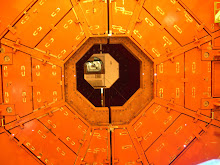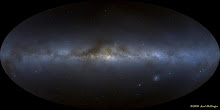 Alan Gillis reports: Time is running out for a permanent fix to Japan's 6 Daiichi reactors in Fukushima. With major damage to four of the units, and core damage to three, the EU's Energy Commissioner said yesterday that the situation is "effectively out of control". A look at the satellite image above courtesy DigitalGlobe.com makes it abundantly clear, though not clear enough to authorities in Japan.
Alan Gillis reports: Time is running out for a permanent fix to Japan's 6 Daiichi reactors in Fukushima. With major damage to four of the units, and core damage to three, the EU's Energy Commissioner said yesterday that the situation is "effectively out of control". A look at the satellite image above courtesy DigitalGlobe.com makes it abundantly clear, though not clear enough to authorities in Japan.Japan's nuclear energy giant, TEPCO, that operates this and other nuclear plants, backed by the Japanese government is still proceeding on a heroic mission to save Daiichi from total meltdown with last ditch attempts to cool the reactors and their spent fuel ponds. Seawater injection, the only coolant option, led to the hydrogen explosions and more seawater dumped later by helicopters over the wreckage hasn't been effective. Water cannon couldn't get close enough because of high radiation levels. Most of the support staff have been evacuated leaving behind about 180 workers in the hot zone to do what they can. To limit their exposure to radiation they work in rotating shifts of 50 risking their lives in a fight that looks like it's been ripped out of the pages of history. It's the Alamo again, but if these Japanese heroes fail, it will mean many more dead, and a dead zone that could spill into Tokyo and cripple Japan for a generation or more.
Huge gas-fired pumps have been ordered to augment cooling, the electrical line to Daiichi is being repaired, a new power line should be working today, but even if the reinforcements get inside, the earthquake and tsunami, and the hydrogen explosions, no doubt have reduced the old diesel pumps, the miles of piping and wiring on site into a tangle of rusted industrial scrap.
If Daiichi wasn't a nuclear plant and a dangerous nuclear hot zone an army of 5,000 would have to work for 6 months to get it running again. There's no time to save Daiichi from itself. It's nearly 40 years old and failed miserably. Scheduled for decommissioning soon, but not soon enough, it's now another tragedy that was almost avoided.
To rig it as a tomb for the reactors and their spent fuel ponds which are installed stupidly on a floor above the reactors; to arrange for round the clock cooling for even a hundred years, can't be done in a few days while a catastrophic meltdown threatens Units 1 through 4. Units 5 and 6 could be saved as the reactors had been emptied of fuel rods for maintenance before the mega 9.0 earthquake, the latest estimate of the violence of the cataclysm. Unit 4 could have been saved as it too was under maintenance but the spent fuel pond there has caught fire twice, and threatens a meltdown by itself that would also destroy its empty reactor underneath.
So why go this route when it's extremely unlikely that a full meltdown in 4 units can be prevented? Ask the IAEA, ask CERN, ask the DOE in the USA. Obviously the Japanese are in shock or in controlled panic mode. "Endure the unendurable" as the Emperor of Japan told his people on national TV the other day. Laudable and understandable, but the Japanese can't evaluate their own tragic situation when it consumes them on every front, three disasters in one, earthquake, tsunami and now meltdown. BBC Video on the Fukushima no man's land.
![]() The Search For Survivors In Fukushima
The Search For Survivors In Fukushima
The only real way to contain Japan's nuclear disaster, was proposed 2 days ago by the eminent physicist Michio Kaku. Like at Chernobyl, to stop the continuing escape of radiation, to save what you can of the land and the people, you need to act now and entomb the reactors of Fukushima Daiichi with sand and concrete, the Chernobyl Sarcophagus solution. So far no one in authority has been willing to discuss his ideas in public, and even the large community of physicists who must see the handwriting on the wall are strangely silent. Michio Kaku seems to be standing alone while his colleagues, perhaps fighting with their own internal PR demons, are strangely silent. Everything's fine. Experts are in charge. It's not my fight. Why look foolish if I happen to be wrong?
What's not happening, is also news. And nothing much is happening. An army of physicists like 10,000 at CERN are not on the march to save Japan.
The whole dirty nuclear industry spawned by physicists is at stake. So ignore or tangentalize or minimize any unpleasant connection to noble theoretical and experimental physics. It's all Politics and Public Relations and we are scientists. If that's not it, what is the truth? Physicists don't fcare?
Well the same sort of selfish thinking might be going on within the nuclear industry. Admitting defeat and burying a nuclear embarrassment in low tech sand and concrete would be the end of a nuclear Japan. Motivations never admitted by the major players, but then the media doesn't ask for elemental explanations either. The best we get is a Japanese monster movie.
"Uncontrolled burst of nuclear radiation reported, Mr Prime Minister."
"Hai".
"Strange giant sea creature in Sea of Japan."
"Whaaaat?"
For the best overview of the damage to Fukushima Daiichi with before and after satellite images, see this 9 page pdf from DigitalGlobe.
For excellent technical and readable updates on what's going on at Fukushima Daiichi, see this special MIT website, mitnse.com
Also on the special MIT website an article "On worst case scenarios" shows that water cooling may slow the destruction of reactor vessels of steel shielded with concrete during a meltdown as at Daiichi.
In the article below from NewsHammer, you'll find my first impressions of the cascade of disasters that have hit Japan so brutally. Also included the compelling ABC News video interview with physicist Michio Kaku where he warns Japan to act now.
--Alan Gillis
 Fukushima Daiichi Out Of Control
Fukushima Daiichi Out Of ControlUnstoppable forces suddenly come, suddenly go while unleashing a cascade of events as bewildering as all the destruction. Inevitable consequences wash over those of us still left standing like a tangible fate that won't stop until there's nothing left. What can we do anyway, especially behind a TV or laptop? Yet there are some who can act and have the power to save Japan from a second wave of disaster. But as part of the usual status quo that rarely acts in time, are politicians and scientists going to ignore the obvious or help us this time?
The big event still to come is not obscure, not buried in disaster upon disaster. It explodes literally at Fukushima near Tokyo, from a 6 reactor complex, that while we watch, explodes and explodes three times in a row sending out great clouds of dust and smoke and nuclear particle radiation. A 30 km radius evacuation of 180,000 people but radiation now detectable beyond Japan in the adjoining Russian Islands. Many Japanese stay put without other clear and better options. Go where, do what?
What do we do? We watch. We talk. Foreigners scramble to fly home. Many remember Three Mile Island and Chernobyl. Low levels of radiation still, but for how long? The best guess of an ultimate disaster brewing is that one of the three most damaged nuclear reactors, Number 2 is breached and Number 2 is likely at risk for an actual full meltdown of its core.
American Physicist Michio Kaku Warns Japan
"Sandbag the reactors" or do what the Soviets did to stop Chernobyl. (Alternate video link)
The worst case now is not like Chernobyl, not a sudden and catastrophic steam explosion of the containment building and its reactor, releasing a enormous cloud of deadly radiation that drifted across Europe into the British Isles. Something more like Three Mile Island so far except there's no safe way to cool down Number 2. Injecting seawater to cool the overheating reactors caused the hydrogen explosions at Fukushima. Physicists knew it could happen and warnings were given, but there was also no choice they said. Something had to be done to prevent the meltdowns.
With failures evident and failures spreading, it seems we are waiting for a worst case scenario before we act. Then it could be too big and too late. Not one nuclear meltdown but six. Telling the Japanese who haven't left the Fukushima disaster zone to stay inside their homes and wash and dry their laundry indoors won't work for long. Watching some experts say it's too early to tell and it can't happen here is no help either.
Perhaps the other 10,000 nuclear physicists watching the resumption of experiments at CERN's Large Hadron Collider today, were too busy to notice what's been happening in Japan.
Seriously, why the wall of silence around CERN? The foremost nuclear lab in the world always chatting up its nuclear safety at the LHC every chance it gets, and the great discoveries always over the horizon? CERN has nothing to say to Japan? No CERN plan to save Japan? Not CERN's job? Fiddle while Rome burns?
There are pictures and video and commentators telling us what they see, but no real discussion of the events at Fukushima. Details are sketchy they say. Why? Is it the Charlie Sheen effect? No time for the real world? So we should wait? It's an International Emergency that can wait? One more day, one more explosion can change everything. If the Japanese aren't prepared to act now and entomb Fukushima Number 2, they may never be able to contain the meltdown that would also threaten the other 5 already damaged reactors nearby.
Besides 3 explosions another had a fire around its heavy water swimming pool spent fuel storage pond. A lot of extremely hot rods close to the reactors, way more fuel waiting for a fire. The 2 of the 6 reactors not in the news, not hit with explosions or fire, also suffered some coolant loss. All this damage in one space that could fit on a big shopping mall parking lot.
According to Dr Kaku there is only one solution and that is to bury the reactors now including the most dangerous Number 2 in sand and concrete like Chernobyl. If not Number 2 at least we could see a more dangerous Nuclear Fire and Meltdown. At Chernobyl it seems the reactor was destroyed and its fuel rods were smashed and scattered into something of a deadly hot heap of nuclear material and rubble.
At Fukushima Number 2 it would be hotter still. You have concentrated fuel rods still aligned and close to each other, though separated by graphite rods inserted during automatic shutdown to slow down the fission reaction. The extremely hot and probably partially melted rods are all in a tight fitting mass within the jacket of a 6" thick stainless steel vessel that has partially
ruptured. When the steel melts away opening a nuclear fire pit how would you get close enough then to use the Chernobyl sarcophagus option? How close can you get to an open nuclear fire? Then if you're still alive try dumping sand on a fire that melts stainless steel.
Many first responders died horribly after extreme radiation exposure at Chernobyl and many others in the disaster zone later of slower cancers. That could be avoided now in Japan. Wait and see from physicists and government could mean six nuclear fires on Tokyo's doorstep. The scientific community which is often in its own catatonic state of theoretical R&D and pension plans needs to wake up to this emergency. After all didn't the physics and engineering branch give us Chernobyl in the first place?
Remember the 1950's PR that started the nuclear industry? "Harnessing the Atom" as they called it. And this soon after Hiroshima and Nagasaki? What next? "It can't happen in America" commercials and "tell your Congressman about today's safe nuclear option"?
This Story Starts To Break
Reuters Video: IAEA: Japan nuclear plant damage "worrying"
Reuters: Chernobyl clean-up expert slams Japan, IAEA
Reuters: Timeline: Japan's unfolding nuclear crisis
--Alan Gillis

 Cointrin
Cointrin

























No comments:
Post a Comment